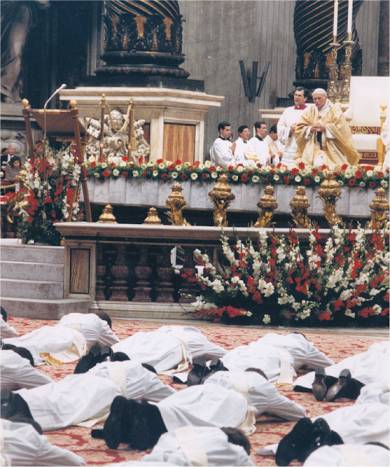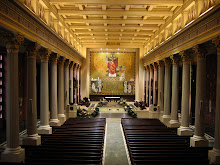
Having returned from a visit to Rome, my fifth visit to the Eternal City, I have recapped the events of the journey, but am yet to offer the 'why' of a visit.
Why should a Catholic, otherwise of good standing, visit the Eternal City? It is certainly not a requirement, for many a good Catholic, even Saints of the modern times, have never visited. But ask anyone who has journeyed to the Tombs of the Apostles, and they will relate a lasting impact.
What is this lasting impact? I have five thoughts:
1) Universality. To visit Rome is to experience the universality of the Church, which is rarely experienced in the local parish. At the Pallium Mass on the Feast of Sts. Peter and Paul, 38 Archbishops from all five inhabited continents were present: the Americas, Europe, Asia and Africa; each bringing his own local flavor and character; exemplifying 'unity in diversity.' For while there were many languages spoken, we were united in Latin and by our common Faith in Christ Jesus under the leadership of the Holy Father.
A quick story illustrates: While the pilgrimage group was in St. John Lateran Basilica, a priest approached me and asked in, I think, either Italian or French, if I could hear a few confessions. Um..., 'Inglese?' Nope, he didn't speak English. German? AH! We have found a common language and could discuss what was needed. He was a chaplain of a small boys boarding school, high school or college, I couldn't tell which, and the eight or so young men would like to avail themselves of the Sacrament. I couldn't accomadate, as I don't speak French, but here we were, all pilgrims from various lands, seeking out a commong heritage.
2) Historicity. The Catholic Faith lives and breathes History, and in fact is the author of so much history. To visit Rome is to be steeped in the movement of the Spirit across the sands of time. It is a relatively short walk from the Mamertime Prison, where St. Peter was held prior to his trial, to the famous basilica bearing his name. In Rome, it is so easy to make those connections, to walk the levels of history to experience the growth of the faith from a persecuted minority, the Church of the Martyrs, to some small remnants of the medi-eval times, through the glory of the Renaissance and the emergence of the Modern Papacy, and so much inbetween.
Yet, it is not just the 'impressive' stuff, that attracts. The tomb of Philip and James are kinda off the beaten path and you have to know they are there to find them. The smaller Churches in and around Rome fostered the devotion of countless saints and heroes in the faith, many of whom have been lost to the passage of history. The Catacombs reveal a tenderness for the body which we have lost today. Yet, in all of this, one recognizes very clearly: Catholicism loves history, embraces her past and looks forward to the future.
3) The Papacy. We have been blessed in the last 30 years with exceptional Popes, and one could easily extend that over the last 100 plus years. Freed from the confines and trappings of the Papal States (even if I did not honor the tomb of Vittor Emmanuel in the Pantheon!), the Modern Papacy has had some of the clearest teachers and defenders of the Faith among those who have sat on the Throne of Peter. What treasures they are. It has been an honor to be at Masses celebrated by both Pope John Paul II and Benedict XVI, and while it is the same Mass, the same Lord Jesus Christ as is present at any Mass, to experience the charisma of JPII and the quiet power of BXVI is to experience the Mass in fullness. What a blessing it is that we have been given the Papacy, men to lead us through the trials and tribulations of the Modern World and to constantly remind what it is to be Christian and Catholic. Long Live the Pope!
4) Cultures. One of the charms of the Eternal City is the mixing of many cultures present therein. To walk from the Flavian Ampitheatre (aka Colosseum) up the Via Forii Imperiali, past the Vittor Emmanuel Moment (aka Wedding Cake) and continue past the Gesu to St. Peter's and the Vatican is to experience 2000+ years of cultural development, and how the Church has 'inculcated' herself across time, even in the face of difficulty. The Church does not exist in a vacuum, but has constantly upheld what was good in the culture in which she dwelt, while simultaneously challenging that which was evil. I thought of this as I passed a Methodist Church yesterday while driving back to the parish. The sign on the door: 'Open hearts, Open minds, Open doors.' Yes, fine, ok; come as you are; but with Catholicism one must add: 'be conformed to Christ, Crucified!' The Church has always been the leavening agent to bring Him into what we do.
5) Art. (possibly tied with the last point.....) Rome is a city of Art, and so much of it free to view. At the dawn of the modern age, the Church was the patron of the Arts, she commissioned the best and brightest artists of the day to compose phenomenal works that still imbibe a passion: the Pieta, the Sistine Chapel, works of Caravaggio, the Gesu, etc, etc. The Church has seen these as part of not only her patrimony, but the patrimony of the human race, expressing in form St. Augustine's maxim: 'Our hearts are restless until they rest in you, O Lord.' We have all heard the critique that 'the Church should sell off all those works and give the money to the poor!' (Haven't we heard this before, from lips I don't want to be quoting!) Yet, if the Church did indeed sell the Pieta to the highest bidder, one would no longer have the free access to see one of the most powerful sculptures ever made. What would be the cost of admission to that museum, if it was even shown?
I am sure there are more, this is what I could think of for the day. Every time I visit, I see something new, experience something deeper and come home enriched in my faith and more in love with the Church. Hopefully those who have not yet made it to Rome will experience something of the Eternal City in these humble reflections.










No comments:
Post a Comment